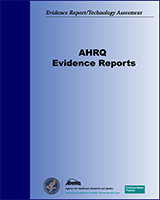This publication is provided for historical reference only and the information may be out of date.
Treatment of Degenerative Lumbar Spinal Stenosis
Evidence Reports/Technology Assessments, No. 32
Authors
ECRI Health Technology Assessment Group.Structured Abstract
Objectives:
This report assesses the clinical evidence describing the natural history, diagnosis, and treatment of degenerative lumbar spinal stenosis (LSS). LSS causes low back pain, radiculopathy, and neurogenic claudication and impedes normal physical activity. LSS is commonly diagnosed in the elderly. Medicare records indicate that the rate of LSS surgery in the United States is between 30 and 132 per 100,000.
Search strategy:
A comprehensive data set was obtained by searching MEDLINE®, EMBASE®, and 23 additional electronic databases; the gray literature; and the World Wide Web and by hand-searching article bibliographies. Date ranges spanned from database inception to July 2000. Our searches yielded 4,788 items for evaluation.
Selection criteria:
Broad inclusion criteria were used to ensure that no relevant information was overlooked. All controlled studies of natural history and conservative treatments, and all clinical studies of any design with relevant quantitative data on diagnostics and surgical treatment were included in our assessment.
Data analysis:
We performed meta-analyses on combinable data using the standardized difference between means (Hedges' d) as the test statistic and checked for heterogeneity using the Q test and each study's standardized residual. The ∪ statistics, graphical representations, and binomial effect size displays were used to interpret the results.
Our quantitative analyses of data that did not permit combination consisted of performing de novo statistical analyses of published data. Effect sizes (Hedges' d) were calculated, and statistical power analyses were performed.
Main results:
Our meta-analyses, based on the few available studies, suggest that patients with congenitally narrower spinal canals are more likely to exhibit LSS symptoms and that patients with symptomatic LSS may have smaller canals. Considerable overlap exists between the spinal diameters of patients with and without LSS diagnoses. Some circumstantial evidence indicates that the development of symptomatic LSS may be influenced by patient age, weight, and occupation and osteoarthritis of the hips.
Definitive conclusions cannot be made about the efficacy of diagnostic imaging methods or of conservative or surgical treatments for LSS. Evaluation of conservative treatment trials is complicated by the lack of patient inclusion criteria restricted to lumbar spinal stenosis. Evaluation of specific surgical techniques is difficult because relevant controlled studies often used demonstrably different patient groups. Trials that compare conservative to surgical treatment also fail to examine patients with similar clinical signs and symptoms. One randomized controlled trial provides evidence that patients with severe symptoms will benefit more from surgery than conservative therapy. Data from a single cohort study suggest that at one year after treatment, patients with moderate pain will benefit more from surgery than from conservative treatment.
Conclusions:
Definitive evidence-based statements about the diagnosis and treatment of LSS await the results of well-designed clinical trials. Available data imply that patients with narrower spinal canals may be more likely to develop some symptoms of LSS. The relationship between degree of stenosis and severity of symptoms is unclear and cannot be quantified. Some evidence suggests that patients with moderate to severe symptoms will benefit more from surgery than from conservative treatment.
Prepared for: Agency for Healthcare Research and Quality, U.S. Department of Health and Human Services.1 Contract No. 290-97-0020. Prepared by: ECRI, Plymouth Meeting, PA, Health Technology Assessment Group.
Suggested citation:
ECRI Health Technology Assessment Group. Treatment of Degenerative Lumbar Spinal Stenosis. Evidence Report/Technology Assessment No. 32 (Prepared by ECRI under Contract No. 290-97-0020). AHRQ Publication No. 01-E048. Rockville (MD): Agency for Healthcare Research and Quality; June 2001.
This report may be used, in whole or in part, as the basis for development of clinical practice guidelines and other quality enhancement tools, or as a basis for reimbursement and coverage policies. Endorsement by the Agency for Healthcare Research and Quality (AHRQ) or the Department of Health and Human Services (DHHS) of such derivative products may not be stated or implied.
The authors of this report are responsible for its content. Statements in the report should not be construed as endorsement by the Agency for Healthcare Research and Quality or the U.S. Department of Health and Human Services of a particular drug, device, test, treatment, or other clinical service.
- 1
2101 East Jefferson Street, Rockville, MD 20852. www
.ahrq.gov
